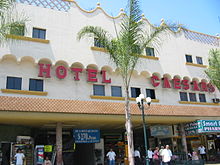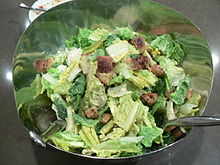This is an old revision of this page, as edited by ZappyWrites (talk | contribs) at 14:26, 23 November 2023 (Rewrote citation 4 in order to fix a typo and to remove a link to a Misplaced Pages article that does not exist.). The present address (URL) is a permanent link to this revision, which may differ significantly from the current revision.
Revision as of 14:26, 23 November 2023 by ZappyWrites (talk | contribs) (Rewrote citation 4 in order to fix a typo and to remove a link to a Misplaced Pages article that does not exist.)(diff) ← Previous revision | Latest revision (diff) | Newer revision → (diff) Green salad of romaine lettuce and croutons
 | |
| Course | |
|---|---|
| Place of origin | Mexico |
| Region or state | Tijuana, Baja California |
| Created by | Caesar Cardini |
| Invented | 1924 |
| Serving temperature | Chilled or room temperature |
| Main ingredients | Romaine lettuce, croutons, Parmesan cheese, lemon juice, olive oil, egg, Worcestershire sauce, anchovies, (Optionally) Dijon mustard, black pepper |
| Variations | Multiple |
A Caesar salad (also spelled Cesar, César and Cesare) is a green salad of romaine lettuce and croutons dressed with lemon juice (or lime juice), olive oil, egg, Worcestershire sauce, anchovies, garlic, Dijon mustard, Parmesan cheese, and black pepper.
In its original form, this salad was prepared and served tableside.
History
The salad's creation is generally attributed to the restaurateur Caesar Cardini, an Italian immigrant who operated restaurants in Mexico and the United States. Cardini lived in San Diego but ran one of his restaurants in Tijuana to attract American customers seeking to circumvent the restrictions of Prohibition. His daughter, Rosa, recounted that her father invented the salad at the Tijuana restaurant when a Fourth of July rush in 1924 depleted the kitchen's supplies. Cardini made do with what he had, adding the dramatic flair of table-side tossing by the chef. Some recountings of the history state that Alex Cardini, Caesar Cardini's brother, made the salad, and that the salad was previously named the "Aviator Salad" because it was made for aviators who traveled over during Prohibition. A number of Cardini's staff have also said that they invented the dish.


Julia Child said that she had eaten a Caesar salad at Cardini's restaurant in her youth during the 1920s. In 1946, the newspaper columnist Dorothy Kilgallen wrote of a Caesar containing anchovies, differing from Cardini's version:
The big food rage in Hollywood—the Caesar salad—will be introduced to New Yorkers by Gilmore's Steak House. It's an intricate concoction that takes ages to prepare and contains (zowie!) lots of garlic, raw or slightly coddled eggs, croutons, romaine, anchovies, parmeasan [sic] cheese, olive oil, vinegar and plenty of black pepper.
In a 1952 interview, Cardini said the salad became well known in 1937, when Manny Wolf, story editor and Paramount Pictures writer's department head, provided the recipe to Hollywood restaurants.
In the 1970s, Cardini's daughter said that the original recipe included whole lettuce leaves, which were meant to be lifted by the stem and eaten with the fingers; coddled eggs; and garlic infused olive oil. The dressing is rarely uniformly made, and anchovy paste is sometimes added with Worcestershire sauce, dry mustard and garlic to enhance the flavor of the olive oil. Several sources have testified that the original recipe used only Worcestershire sauce without any anchovies, which Cardini considered too bold in flavor.
Although the original recipe does not contain anchovies, modern recipes typically include anchovies as a key ingredient, which frequently is emulsified in bottled versions. Bottled Caesar dressings are now produced and marketed by many companies.
The trademark brands, "Cardini's", "Caesar Cardini's" and "The Original Caesar Dressing" are all claimed to date to February 1950, although they were only registered decades later, and more than a dozen varieties of bottled Cardini's dressing are available today, with various ingredients.
As the salad moved North to the U.S, a key ingredient changed within the recipe. Lemon juice is commonly used, despite the original Caesar salad opting for lime.
Common ingredients


Common ingredients in many recipes:
- Romaine or Cos Lettuce
- Olive oil
- Crushed Garlic
- Salt
- Dijon mustard
- Black pepper
- Lemon juice
- Worcestershire sauce
- Anchovies
- Raw or Coddled eggs
- Grated Parmesan cheese
- Croutons
Variations include varying the leaf, adding meat such as grilled chicken or bacon, or omitting ingredients such as anchovies and eggs.
Vegan versions can replace anchovies with capers and the eggs with tahini.
Health concerns
Main article: Egg as food § ContaminationThere is inherent risk of infection by salmonella bacteria occasionally found in raw egg from cracked or improperly handled eggshells where the protective cuticle is damaged. Updated recipes recommend eggs that are briefly heated to 160 °F (71 °C) or pasteurized eggs. Some variations of the dressing may use substitutions for egg.
See also
Citations
- Burke, David; Choate, Judith (2009). "Caesar salad". David Burke's New American Classics. Knopf Doubleday Publishing Group. p. 67. ISBN 978-0-307-51943-6. Archived from the original on 7 July 2021. Retrieved 12 July 2016.
- "Cesar Cardini, Creator of Salad, Dies at 60". Los Angeles Times. 5 November 1956.
Caesar Cardini, 60, credited with the invention of the Caesar salad, died
- "Rosa Cardini". The Telegraph. 21 September 2003. Archived from the original on 27 March 2019. Retrieved 10 February 2012.
- Ryan, Patrick Spaulding (31 December 2022). "Una Corrida Extraordinaria". SSRN.
- Grant, Dorothy (15 June 2007). "Hail to all fathers, and hail Caesar!". TCPalm. Archived from the original on 8 March 2016. Retrieved 17 December 2020.In , D. Grant quotes Aviator's salad and more (2007)
- "The History of Caesar Salad". Kitchen Project. Archived from the original on 2 July 2007. Retrieved 18 December 2020.
- ^ Child, Julia; Child, Paul (1975). From Julia Child's Kitchen. New York: Alfred A. Knopf. ISBN 978-0-394-48071-8.
- Kilgallen, Dorothy (2 August 1946). "The Voice of Broadway". The News-Herald (Franklin, Pennsylvania). p. 4. Archived from the original on 2 November 2020. Retrieved 18 December 2020.
- Hawkes, Graham (27 August 2014). "Hail, Caesar's salad". Stuff. Retrieved 13 February 2023.
- "The History of Caesar Salad". kitchenproject.com. Retrieved 13 February 2023.
- ^ Witchel, Alex. "Great Caesar's Ghost! Where's My Anchovy?". The New York Times. The New York Times. Retrieved 1 October 2022.
- "The Best Caesar salad". Seriouseats.com. Archived from the original on 12 June 2018. Retrieved 30 May 2018.
- "Serial numbers 73426710 "Cardini's", registered 1983 by Caesar Cardini Foods". United States Patent and Trademark Office. Archived from the original on 13 July 2021. Retrieved 15 March 2022.
- "Serial numbers 73782270 "The Original Caesar Dressing" and "Caesar Cardini's", registered 1989 by Dolefam Corporation, which later merged with T. Marzetti". United States Patent and Trademark Office. Archived from the original on 13 July 2021. Retrieved 15 March 2022.
- Gora, L. Sasha. "The surprising truth about Caesar salad". www.bbc.com. Archived from the original on 31 March 2021. Retrieved 23 April 2021.
- "Caesar Salad". Credo Reference. Encyclopedia of American Foods. Retrieved 30 May 2022.
- "Vegan Caesar Salad Recipe". Ambitious Kitchen. Monique Volz. Retrieved 9 September 2022.
- "Should eggs be washed before they are used?". AskUSDA. United States Department of Agriculture. Retrieved 1 October 2022.
- "Egg Products and Food Safety". United States Department of Agriculture Food Safety and Inspection Service. 10 August 2015. Archived from the original on 16 January 2021. Retrieved 17 December 2020.
General and cited references
- Julia Child; Paul Child (1975). From Julia Child's Kitchen. Alfred A. Knopf. ISBN 978-0-394-48071-8.
Further reading
- Greenfield, Terry D. (1996). Lorna Bolkey; Kathryn Hall (eds.). In Search of Caesar: The Ultimate Caesar Salad Book. Alexander Books. ISBN 978-1-57090-014-3.
- Mariani, John F. (1985). The Dictionary of American Food and Drink. Book Sales. ISBN 978-0-89919-199-7.
- Stradley, Linda; Cook, Andra (1997). What's Cooking America. Chehalem Publishing. ISBN 978-1-885221-55-1.
- Trager, James (1995). The Food Chronology: A Food Lover's Compendium of Events and Anecdotes, from Prehistory to the Present. Henry Holt and Company. ISBN 978-0-8050-3389-2.
External links
| Salad dressings | ||
|---|---|---|
| Condiments |  | |
| Types | ||
| Manufacturers | ||
| Mexican cuisine | |||||||||||
|---|---|---|---|---|---|---|---|---|---|---|---|
| List of Mexican dishes | |||||||||||
| Soups and stews | 
 | ||||||||||
| Rice and pasta dishes | |||||||||||
| Bean dishes | |||||||||||
| Egg dishes | |||||||||||
| Vegetable dishes | |||||||||||
| Meat dishes |
| ||||||||||
| Other protein dishes | |||||||||||
| Cheese dishes | |||||||||||
| Antojitos |
| ||||||||||
| Sauces and condiments | |||||||||||
| Desserts and sweets | |||||||||||
| Salads | |||||||||||
| Breads | |||||||||||
| Beverages | |||||||||||
| Variants |
| ||||||||||









